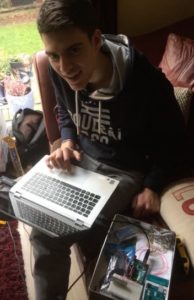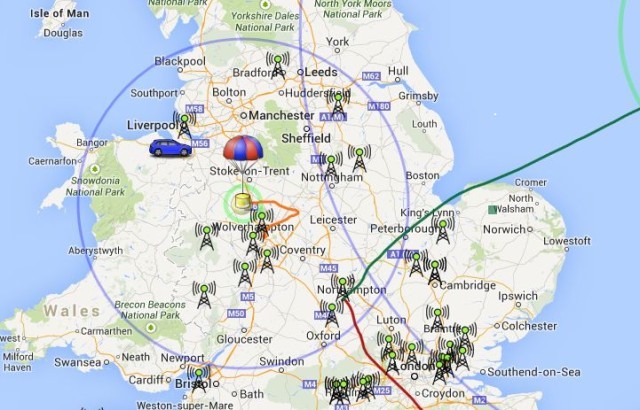Author: Jacob Smith -
Hello! I'm Jacob, a Mechanical Engineering student currently on placement at Airbus Defence and Space in Stevenage, UK. I have always been interested in space, and having finally been reintroduced to the idea of 'my own free time', I decided to fulfil my dream of sending something into space. That thing – a box on a very big balloon…

Launching a High Altitude Balloon (HAB) is a surprisingly popular hobby, especially in the UK, having been termed the 'poor man's space program'. It involves sending a payload – usually a polystyrene box containing a camera and a tracking device at minimum, to altitudes of about 30km on a weather balloon. Technically this is an area called near space (up to 100km) not space (above 100km). My main aim is to capture video and images of the beautiful earth against the black backdrop of space. I will be so happy if I can pull this off!
The Basics
Before I start talking about everything I will have to do, I would just like to give a basic idea about how flights work and list a few things that can make them challenging, helping you understand my decisions throughout the project
- A large balloon made of highly flexible latex is filled with either Helium (more expensive) or Hydrogen (don’t – it’s a lot more flammable). Both these gases are lighter than air so will lift the payload off the ground. As the balloon rises it increases in diameter due to the decrease in air pressure, until it bursts. The parachute, attached between the balloon and payload, will then open slowing down the descent of the payload.

Basic set-up of a High Altitude Balloon - Temperatures can get down to -60°C making it important to select suitable components and thoroughly test them.
- It is vital to wait for the right weather and get permission from the Civil Aviation Authorities. I hope to be ready to launch in the summer when there is less risk of strong winds carrying the balloon into the sea or even beyond. You wouldn’t want to lose all your hardware.
Research, research, and more research
I spent a few weeks reading about and being inspired by similar projects that other people have done, learning about the systems and components required, and determining if I could really do this. Flights can vary greatly in complexity and hence time and cost. Because this is the first time I am doing anything like this I decided to keep it simple which will keep the cost and chance of it going wrong relatively low. I am, however, wanting to learn new skills in carrying out this project, so I will be doing everything myself and not buying pre-made kits.
Without a working tracking system there is no way of finding the payload once it lands and retrieving those Earth images you have worked so hard to get. For this reason, I decided to first create a reliable tracker, otherwise there was no point in doing everything else.
There are a few general options when tracking a HAB flight in the UK.
1. Mobile phone or GPS/GSM trackers
Cheap and simple mobile phone and GPS/GSM trackers will send you their current location when you send a text to/call the number. It didn't take much time to rule out using these methods, having to rely on landing somewhere where the device can pick up a signal, assuming it is still operating after a couple of hours in extreme temperatures, is a risk I do not want to take. They would only have signal close to the ground, up to a few 100m, so without the ability of live in-flight tracking I would have to wait for it to land before I had any idea where it was.
2. SPOT tracker
SPOT trackers, intended for use mainly by hikers should they get into trouble, are quite a popular choice for HAB flights. They use a different satellite network to GSM so will work up to a greater altitude of 12km, but this still covers less than half the target altitude. SPOT trackers only work when facing towards the sky, a problem if the payload box were to roll over on landing, and are quite expensive due to the yearly service fee required to actually use the device.
3. UKHAS (UK High Altitude Society) Tracking System
The UKHAS Radio Tracker system is a system developed in the UK and is the recommended and most widely used among HAB hobbyists. An onboard tracker picks up its current position and a radio module transmits it down to antennas on the ground. The great thing about this is the extensive network of listening stations i.e. anyone with a suitable antenna can get the location and automatically upload it to a central server, helping you track your flight (see image below). Trackers are available to buy online, but for a much more rewarding project, you can create your own. This is what I decided to do…

A way forward
If done correctly, this will be the most reliable tracking method. To receive a signal you need line of sight from your payload transmitter to your receiver on the ground. There is no doubt that this is the best method as signals have been received up to 400km away! Having never really been interested in electronics and armed with only a very basic knowledge, this would be the hardest part for me. But I was keen to learn about and develop an understanding of electronic systems. I am very grateful for the guides available on the UKHAS website.
I am excited to start this project and now have a clearer direction of how I will carry it out. I have a list of the components I will need, and now just need to find and order them. I hope you have enjoyed reading about my idea, and that you will follow my journey to near space. I am happy to answer any questions in the comments below. In my next post I will describe how I will go about building my radio tracking system.


Really enjoyed reading this Jacob. And looking forward to the next update...
Jacob. Sounds like a fantastic project, I'm looking forward to hearing about the results and tracking your progress. Good luck.
Hello! Hope all is well. Thank you for your comment, sorry for the late reply I've only just seen it. Please keep up to date with the project...hopefully it won't, but if the balloon travels too far and lands off the land I may need you to direct your ship off course 😉
Can't wait to see some footage.. Best of luck!!!
Neither can I! Thank you!
Hi
Did you do this? ANy updates anywhere we can see. Love to know how you got on.
Louis
Hi Jacob, really interesting post. I hope you managed to achieve your objective at the end. I'm also thinking about embarking on similar project, but guidance and advice from someone experienced would really helpful. I would be really grateful if you accepted my invitation to share our contact details for direct communication. I'm also currently working in the aviation industry, so maybe we could help and support each other.